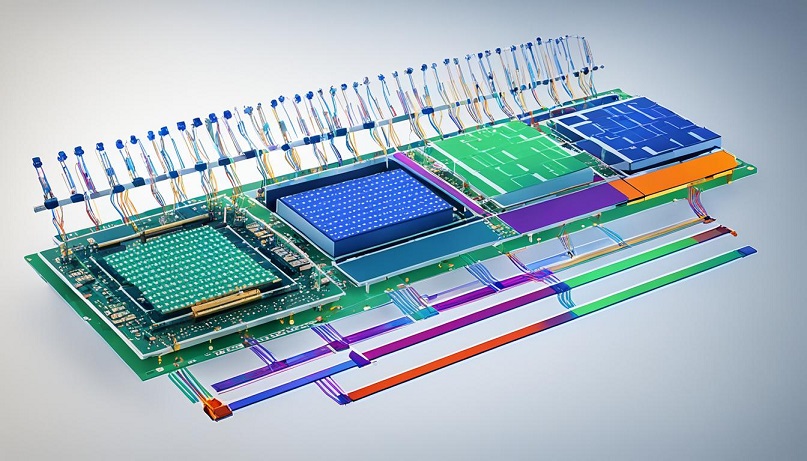The world of electronics has changed dramatically, but is it possible to confirm that it is possible due to the exceptional transformation in the vlsi design? From the first coin-sized transistor to the miniature smart chips in modern devices. It is real evidence that when pushing the boundaries and heading towards progress, one can achieve high goals through human creativity. The following blog post will dive into the mysterious world of VLSI, from the breakthrough eras to the powerful technologies of the latest achievements.
The birth of the transistor
Transistor is just one of the most proper ones of the early 20th century instruments. This piece of equipment was the most prodigious cutting edge development in the history of electronic devices. The transistor was instrumented by -John Bardeen, Walter Brattain, William Shockley- in 1947 and it presented a different method to electronic circuits.
This was made possible by the transistor’s capacitive or switching potential. The invention of the transistor evoked a significant and unique response in that it successfully eradicated the need for the powerful and cumbersome vacuum tubes that were previously utilised. Thus, it empowered the shrinking of electrical gadgets to make them more available, cost-effective, and dependable.
Early Integrated circuits
A significant achievement that took VLSI design to the next level was the birth of integrated circuits and the vlsi circuit. In 1958, Jack Kilby and Robert Noyce both independently invented the integrated circuit. It was a single chip containing many transistors and other electronic components.
The emergence of ICs has had a significant influence on and has entirely revolutionised the electronics industry. Rather than having to put individual elements on the circuit board, engineers may construct everything on a single chip. It made electronic devices less physically miserable and much more efficient. However, the new technology produced other technical breakthroughs and improvements.
The dawn of VLSI
The market needed more powerful and smaller electronic devices; therefore, even more, integration levels were required. VLSI design allowed it to pack millions or even billions of transistors on a single chip. From then on, a new epoch had begun: it changed the way electronic devices are born and made.
It let engineers fit thousands and later millions and billions of transistors on a single chip, creating ultra-powerful and ultra-complex electronic systems, which allowed the development of computers, telephone communication equipment, and everyday electronics.
Moore’s law and scaling
Moore’s Law was one of the drivers of the rapid progress in VLSI design. The law was formulated by Gordon Moore in 1965, an Intel co-founder. The author observed that the number of transistors on a chip doubled around every two years, whereas the cost of production was relatively constant.
This forecast eventually acted as a self-fulfilling prophecy, as for decades, the semiconductor operating segment had tried to achieve an ever-increasing transistor density and chip performance. Manufacturing processes, for example, photolithography and etching methods, kept developing to enable chip makers to place an ever-increasing number of transistors on tinier and tinier chips, consequently creating electronic devices with an ever-increasing power and saving capacity.
Design automation tools
As VLSI was further developed, the necessity of designing special design automation tools arose. Among these was the development of electronic design automation software that allows engineers to handle all the stages of chip design, such as schematic capture, logic synthesis, layout, and verification.
It is an understatement to say that the invention of design automation tools fueled VLSI design’s development because, without them, it would be impossible to address the vast complexity of the modern chip, ensuring accuracy, reliability, and, most importantly – efficiency.
Power management and low-power design
The launch in the count of portable electronic devices, such as smartphones and tablets, made power management and low-power design important considerations in VLSI design. Power usage was reduced both from battery life and from issues related to the dissipation of heat and energy efficiency.
To minimise power consumption in VLSI chips, which was achieved by clocking gating, power gating, and dynamic voltage and frequency scaling were introduced. Power management allowed VLSI designers to build devices that produced high performance while avoiding even using energy; even in this epoch of more computer expression.
System-on-chip (SoC) integration
When the VLSI design concept was constantly improving, new system-on-chip terminology was also introduced. It did, however, involve the provision of a number of different functions in one card as it included processors, memory, input/output interfaces and hardware accelerators without a single chip. The technological advancement accordingly led to the miniaturisation of the systems whilst reducing the power consumption and expense via the production of the compact, low-power, and affordable electronic system.
In short, the complexity of design was the first hurdle to be overcome while verification at the system level had to be improved as well. While design methodologies such as hardware-software co-design and IP reusability facilitate the progress in the SoC designs, these designs become progressively sophisticated and powerful.
Emerging technologies and future trends
Increasing advancements of new technologies and trends in the design of VLSI are driving the evolution. It can be seen in such fields as chip integration in three-dimensional stacking quantum and neuromorphic computing.
First of all, 3D chip stacking allows the integration of many chips vertically, which increases the density and performance and at the same time reduces power consumption and interconnect delay. Second, quantum computing performs some computations based on the principles of quantum mechanics much faster than current classical computers. It introduces new opportunities for cryptography problems and scientific simulations. Third, neuromorphic computing is concerned with the development of memory. It is analogous to human brain architecture to produce specialised hardware doing jobs efficiently.
Conclusion
This great evolution of VLSI design for engineering hardware starting from a simple transistor to an extremely complex power chip that we have in our gadgets is an amazing story of human intelligence and the trajectory of technological development. From the creation of a transistor up to the development of integrated circuits and the era of VLSI design the way was marked with thousands of innovative discoveries.
The future possibilities of VLSI design are entirely dependent on emerging technologies and the race for faster, more efficient, and more powerful electric systems. Whether it is contributing to Quantum computers, neuromorphic processors, or new applications we have not even thought of yet. VLSI design will most certainly be an essential factor in the future technological landscape.



